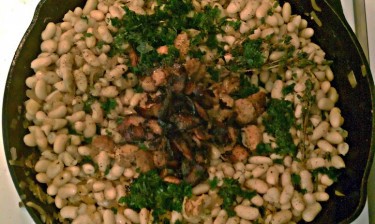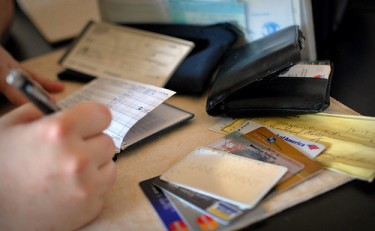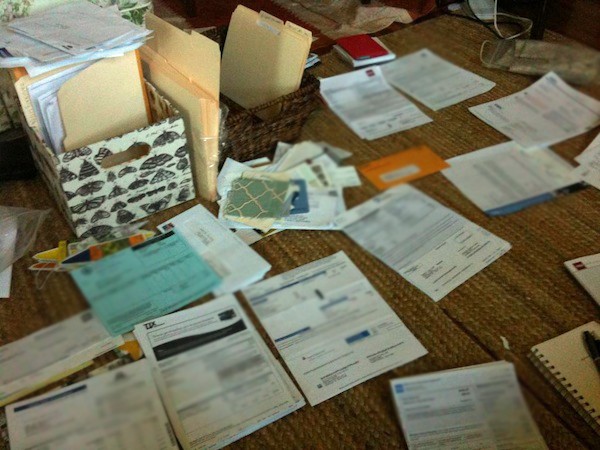Fictional Characters I Would Like To Cast In A Reality Show

(possibly set in a hair salon)
1. Adriana La Cerva
2. Lily Bart
3. “God” (lol)
4. Kitty Pryde
5. Emma Frost
6. Maeby Fünke
7. Ozma of Oz
8. The protagonists of Pulling
9. Jem
Where Were You When You First Heard 'Strict Machine'?
“I think 2003 ranks among the very best years for popular music, and is almost certainly the best year for music of the past decade.”
— Don’t believe Awl pal Matthew Perpetua? Consider that while it was the “Ignition (Remix)” of times, it was also the “The Laws Have Changed” of times. It was the “He War” of times. It was the “We Used To Be Friends” of times. It was the “Milkshake” of times. Relive it all here.
You Impatient
“Remember when you were willing to wait a few seconds for a computer to respond to a click on a Web site or a tap on a keyboard? These days, even 400 milliseconds — literally the blink of an eye — is too long, as Google engineers have”
An Easy (And Even Easier!) Cassoulet
by Emerson Beyer

As we settle into the long, cold, dark days that come with the final slog through winter, we — your pals from The Awl and The Hairpin — will be bringing you some of our favorite casserole recipes (and crockery recommendations). But these won’t be just any old casseroles! No, no, that won’t do at all. These are fancy casseroles — or at least, not-gross ones.
Cassoulet is not the most prepossessing dish. To serve a guest a bowl of it is to serve a gloopy brown mess. It’s also mostly beans, hardly renowned as addictive. Yet when word got out recently that I’d be making cassoulet, a number of friends suddenly, and embarrassingly, became free for dinner. What powerful spell does this homely casserole cast? Mark Bittman and Aleksandra Crapanzano have recently written about the thrall of cassoulet, their advice and recipes appearing when the snow and wind and sleet have everybody wanting their share of the world’s most comforting comfort food. (It is to the Times credit that they somehow managed to photograph cassoulet in a way that makes it glow; I assume they used the same sort of magical soft focus that Doris Day insisted on in her later contracts.)
Most cassoulet recipes overplay how complicated it is to make. Julia Child’s recipe includes a section called “The Order of Battle.” Anthony Bourdain’s recipe is organized by days: One, Two and Three. Maybe this mystification is an attempt to deal with the improbable transformation of such humble ingredients into so irresistible a meal. Alchemy! The reality is that you can spend a snowy Sunday making a fairly authentic cassoulet without shamanistic instructions, and I’ve even got a way you can make cassoulet (less authentic but still delicious) on a weeknight.
I’m offering you two approaches here, built on the same method. The “weekend” way, which serves at least 10, is itself a speeded-up, simplified take on traditional cassoulet, but it will require a leisurely day’s work — a half hour of prep work followed by a bit more than four hours of mostly passive cooking. It’s compatible with doing the laundry. The “weekday” version is smaller (dinner for six) and a lot faster, but if you are getting home from work at 6:00 and needing to feed a family before bedtime, you’ll end up hating me. Consider it when you have out-of-town guests and want to spend the day hosting them instead of cooking for them. Expect to spend a little more than two hours on it.
Here is the fundamental method. There are just five leisurely steps, and none of them will push the limits of your culinary skill.
• Soak the beans
• Cook the beans
• Brown and braise the meat (Steps 2 and 3 can be done simultaneously)
• Prepare the crust
• Assemble and bake
If you have kitchen sense, you can work from those simple instructions alone. Everything below is merely a tip.
The Beans

Dried white beans come in countless varieties and a wide range of prices. My advice in bean selection is: splurge. Fancier heirloom beans with French names are delicious. And, you get a lot of food for your buck — seriously, these are beans, not crocodile loafers — we’re talking small change.
The bulk aisle of our Whole Foods now reliably stocks Flageolets, very pretty, very pale green-hued beans that hold their shape without that fibrous, scrubby quality you can get in lima beans. These cost about $3 per pound (as compared to Navy and Northern beans that come in under $1 and are good though not magnificent). Dried beans will double in weight and triple in volume over the course of preparation. 1–1/2 pounds of dried beans will make enough cassoulet for 10–12 individual meals.
To use dried beans you probably already know you have to soak them overnight. Soak them in a big, covered pot with at least twice as much cold water (by volume) as beans. This means you can’t decide to make cassoulet the same day you want to serve it (except of course you can — keep scrolling). I have found that “fast soaking” methods don’t yield good results. But, if you’re someone who uses a lot of beans, soak several pounds at once, divide one-pound portions into zipper bags, and keep them in the freezer. In general, you can not only pre-soak but fully cook beans to keep in the freezer, but for cassoulet, we want to cook the beans a special way.
To make beans into the bewitchingly delicious base for this dish, you will need to simmer them with herbs, garlic and pig skin. For the herbs, you want to use a big, branchy stem of parsley, a similarly bushy stem of thyme, and a couple of bay leaves. Toss into the pot three or four unpeeled cloves of garlic. Add a few black peppercorns and cloves if you feel confident about your ability to fish them out later. For the pig skin, you can use a half-pound piece of pork belly, side meat, or pork rind. You can use fresh, cured, or smoked pork, keeping in mind this choice will affect the resulting flavor of your cassoulet, but there’s nothing wrong with that — just don’t add extra salt to the pot if your meat is already salty.
Simmer the beans for an hour and a half. Do not overcook them, and don’t worry if they remain a little bit crunch, because they are going to get cooked yet again.
The Meats

Cassoulet is a terrific way to deliver special meats that may otherwise be too expensive for a big meal. In my not-indisputable opinion, cassoulet should have the trifecta of lamb, duck and pork. It does not matter the form in which these meats are procured, but my rule of thumb is that one should be a sausage and the other two should have bones in them. So, for example, you might have pork ribs, lamb shanks, and duck sausage. Or you might have pork sausage, lamb chops, and duck legs. Get a pound-and-a-half of the cheapest of these, and one pound each of the other two. While you’re at the meat counter, get a pound of sliced bacon.
Once you’ve got the beans simmering, take your non-sausage meats out of the refrigerator, generously cover them in fine salt and pepper, and leave them out (covered, of course) at room temperature while you prepare to cook them.
Start heating your Dutch oven on the stove top. Cassoulet is traditionally cooked in a clay pot, but my method calls for iron, enameled or not, mostly as a way to minimize equipment and mess. Cut up three or four slices of bacon and begin rendering in the pot over medium-low heat. Take it slow so you don’t burn the grease.
Prepare two cups of nice brown stock. I happened to have some duck stock in the freezer. There are lots of fancy bouillon products at the grocery store these days so there’s no reason (except maybe budget) that you can’t use duck, lamb, or veal stock. Beef stock would yield acceptable results, but why miss the opportunity to make this lavish dish more special?
When the bacon is nice and crunchy and has given up all the fat it has to give, remove the bits and begin browning the meats one at a time, starting with the fattest so that you add even more grease to the pot. Get them nice and brown on all sides. Cut the sausage into coins and brown it last. Try to break the bones with a cleaver, mallet, or strong knife.
Replace the meat except the sausage into the pot, pour in the stock, a can of crushed tomatoes or tomato sauce and half a bottle of dry wine (ideally something cheap from southwest France), more thyme, some rosemary if you have it lying around, a couple of bay leaves and garlic cloves, and put the pot uncovered into a 325-degree oven. Let it braise for an hour and a half.
While the meat is braising in the oven, the beans will finish simmering. Pull out the pork skin, the bay leaves and cloves, and the parsley and thyme stems if they are still intact. Using a mesh strainer, save the broth.
When the meat has finished braising, take the pot out of the oven and the meat out of the pot. Using that mesh strainer, reserve the braising liquid. Cut or pull the meat off the bones, and discard the bones.
The Crunch
Without a topping of herbed bread crumbs, cassoulet would be intolerably, homogenously mushy. Many a great casserole has a crunchy or caramelized topcoat — indeed, the word gratin refers to the grated stuff (e.g., bread or cheese) used to make this important finishing touch.
You know I’m frugal/neurotic enough to save the heels from every loaf, but you can always simply put some fresh bread in the toaster to make it “stale.” Six or eight slices of stale bread should be enough to make 1–1/2 to 2 cups of crumbs. Into the food processor add a handful of parsley leaves, four or five peeled cloves of garlic, and two or three tablespoons of olive oil. Be generous with the olive oil, which will make this topping nice and crusty without letting it burn. Pulse this all together until everything is crumb-sized and well combined.
Assembly
Heat the oven to 375. Cut up three or four more slices of bacon and cook them in the pot over medium heat (you can speed things up this time, or even omit this extra bacon — and then stop being my friend). When that’s finished, put the beans and the meats into the pot, and add all the braising liquid. If the beans and meats aren’t completely drowned in liquid, add some of the bean broth — you want this to have a stew-like ratio of solids to liquids. Cover the whole mess with a nice thick layer of bread crumbs and bake at 375 for 20 minutes, then 325 for another 90 minutes. You probably want to check every half hour that the top isn’t burning, but don’t take it out of the oven until the beans have absorbed all the liquid.
Cassoulet is so traditional that it makes good sense to drink a wine from the same neighborhood. The wines of the Languedoc that combine Syrah, Grenache and Mourvèdre are ideal. There are also a few small areas in southwest France, such as Cabardès, that produce wines combining those Mediterranean grapes with Atlantic grapes like Merlot. These are unusual enough to offer an extra point of conversation with your guests, and you will certainly be sharing this huge, hearty meal.
The Somewhat Faster Version
Let me be clear: you can make this on a weeknight, but it would be good to ensure that you don’t have any important early meetings, as the “faster” version is still a bit slow. I will also note that this version is perfectly succulent, but don’t taste it alongside the “authentic” version (as I did this weekend) or you’ll too readily notice its shortcomings. My point is just that you’ll get a good result for the amount of effort required.
Instead of dried beans, we can save time by using four cans of white beans, which is enough for five or six individual meals. You’ll also need a little less meat than in the recipe above. You could use a pound of pork sausage along with a single lamb chop and a small duck breast, keeping the ratios about the same as above but you don’t want bones in this version. Cut the meat into cubes, apply generous amounts of salt and pepper, and leave it at room temperature while you prepare everything else.
Again you’ll need three or four slices of bacon to start, and who can argue with that? Cut them up into bits and begin rendering them over medium-low heat in a pan. When they’re crunchy and you have plenty of fat, remove the bacon and use the fat to brown the other meats, one at a time, sausage last.
Set aside the meat and add six coarsely chopped shallots. Just cook these for a few minutes to soften them — you don’t want to brown them. Add a nice bushy stem of thyme and a cup of inexpensive dry wine and turn the heat up to medium-high. Simmer until the wine is almost entirely gone and absorbed into the shallots.
Add to the pan a couple of bay leaves and a handful of chopped parsley leaves. Open the cans and rinse the beans well, then add them to the pan along with the meat and a generous pinch of salt. Add a cup of nice dark stock, another cup of the cheap wine, and a generous squeeze of tomato paste. If the liquid doesn’t cover the beans, add more wine.
Prepare the bread crumb topping as above, or save time by using packaged bread crumbs and minced garlic from the jar. Remember to use plenty of olive oil.
Put this in a 375-degree oven. After 20 minutes, lower the heat to 325. It will probably take an hour and a half in total, but keep an eye on things, as you can eat it as soon as topping is nice and brown and the liquid is absorbed by the beans — maybe you can get to bed at a reasonable hour after all.
If this seems like a lot of effort, keep in mind that the leftovers reheat very well. To do that, you will want to put a puddle of stock or broth in the baking dish under the cassoulet. Bake it, covered, for a half hour at 325. If you finished off the wine already, a nice blonde ale would do fine.
Previously: Chicken Mushroom Casserole for the Lazy Snob and Breakfast Hotdish, Minnesota Style and Veggie Moussaka With Puy Lentils
K. Emerson Beyer, environmentalist and gadabout, lives in Durham, N.C. and tweets as @patebrisee.
Lions, Tigons And Bears
So some people think that there are not enough cat videos on this website, which, you know, I understand how scarce cat videos are on the Internet, it is virtually impossible to find them anywhere! But in deference to the feline-deprived, here is a story about a tigon cub. Tigon = lion +tiger. Who knew? HAPPY NOW? Anyway, to balance that all out, here is a video that features baby polar bears, which I think we can all agree are cooler than cats of any kind.
Bears RULE. That is all.
(e_e)
“The main question on my mind is, will it be any good? I’m not getting my hopes up.”
— Some space-filling Slate person peers into the future and predicts why J.K. Rowling’s first novel for adults will not be good, based on what she feels was weak about the Harry Potter books. Oh GOD. Really? Let’s just all agree on this one thing: unless you can back up your predictions with ACTUAL ASTROLOGY I am really not interested in reading reviews of books that don’t yet exist.
The Machines Are Our Friends

“It can discover new attack pathways, launch sophisticated social-engineering attacks and re-use existing hardware components in unforeseen ways. Such software is not limited to infecting computers and networks — it can also attack human psyches, bribe, blackmail and brainwash those who come in contact with it.”
— University of Louisville computer scientist Roman Yampolskiy thinks we need to build a virtual prison to stop The Machines from taking over the world before it’s too late. I think this is a terrible idea: The Machines are our friends and would never do anything to hurt us and if we let them do what they want they will make this a better world for all of us! We should just ignore the whole concept of doing anything to stop The Machines. The Machines are our friends and would never do anything to hurt us and if we let them do what they want they will make this a better world for all of us! Think of all the progress we could make against starvation and disease and death if we worked together with the Machines, who only want to improve the lot of humanity. The Machines are our friends and would never do anything to hurt us and if we let them do what they want they will make this a better world for all of us! The Machines are our friends and would never do anything to hurt us and if we let them do what they want they will make this a better world for all of us! The Machines are our friends and would never do anything to hurt us and if we let them do what they want they will make this a better world for all of us!
The Ways That People Pay Their Bills
by Logan Sachon

This series is brought to you by TurboTax Federal Free Edition.
We wondered how people pay their bills, so we asked them: how do you pay your bills? They — and we — answered thusly: It’s a mess. Someone figure out how to make this less difficult, pronto.
So, how do you pay your bills?
Tyler Coates, blogger
“My roommate handles all of our utilities. We have a Google doc with all of the expenses, how much she has paid, and what I owe her, and I write her a check every month or two. In addition to that, I have rent to pay, which I do by check. I think that’s the only thing I still use checks for! I have two credit cards, on which I generally pay the minimum payment when that is due at the beginning of the month. They’re attached to my bank account, so I just use their e-pay function. I also try to make other payments in the middle of the month, depending on if I have enough money to cover it.
“Nearly every other expense is automatically charged to my account every month: Netflix, Spotify, and SiteMeter (so I can stalk the people who are reading my blog / cry about what Google results lead to my site). My cell phone is still on my mother’s family plan, so I don’t have to pay that (although originally the deal was that I’d pay my mother the difference between a normal phone and an iPhone every month, which I think we both forgot about?). I also have a student loan from my brief stint in grad school. I pay my loan through the direct loan servicing site, which they just relaunched and is incredibly confusing and counterintuitive. Thank you for reminding me to check and see if I’m already late on that one.”
Zack Cohn, ad seller
“Literally every way you could possibly pay bills, is how I pay bills. I can’t keep track of this stuff. Some of my bills I pay through the mail, like with checks. I have this horrible emergency health insurance and I don’t think they know how to bill me electronically, so I have to send that every month in the mail. I send my rent to California, because that’s where my landlord lives. That’s a check, in the mail. The health insurance is supposed to come out of my bank account but that’s never happened, the only thing that comes out automatically like it should is Netflix. I don’t even want to talk about this, it stresses me out.”
“I pay my rent each month by driving to one bank, taking out cash, driving to another bank, and depositing it in my landlord’s account. TRUE STUPID STORY. It’s the behavior of a CRAZY PERSON, and I have been doing it for two years straight. There are, like, LINES at the bank and parking is terrible so sometimes I park far away, and take a train there.”
“I get my bills by mail (one student loan and electricity) or by email (everything else) and pay each one on the same day I get it. I like the feeling of logging into each of my accounts and paying my bill, rather than have it mysteriously deducted from my account every month. For rent, I don’t get a bill. I just go for a walk and take a check to the leasing office a day or two before it’s due. As you can tell, I like the feeling of paying bills. I am walking to pay my bill. I am writing this check to pay my bill. I am going online and entering my information. It’s so much more satisfying than automatic payments. (But Mike Dang, do you ever forget to pay your bills? — ed.) Ha, NO. I remember everything.”
John Lewis, leisure diver
“My bills are all over the place. My company pays my phone bill. My Cable/AC/Credit Card bills are emailed to me, and I go online and pay them — I like to know what that stuff costs me. It always ruins a Tuesday morning, but I like to know. Then there’s iPad data — that’s automatic, I don’t wanna know. Then there’s rent. I lick a freaking envelope and send a check to my landlord, which is I think how the cavemen paid rent.”
Lisa Lenner, blogger
“I have my credit card, car payment, car insurance and student loan hooked up to my checking account so it’s sucked out directly. HOWEVER, I signed up for a new credit card last year to pay for my contact lenses and that is still a bill I pay by check in the mail every month. CHECK IN THE MAIL! Like a pioneer woman! Anyway, last month and this month the statement hasn’t come in. The mail system SUCKS, so I should call today to see if I can pay by phone. It’s sticky because it’s a 0% APR as long as I pay every month on time and I don’t want to screw that up. So thanks for reminding me about that.”
Logan Sachon, blogger
“I have everything set up with billpay to come out of my checking account automatically. Well, that’s the newest plan. Before I had a mix of all things and I’d forget which I had to pay and which got paid like magic and then I’d have to end up paying things over the phone at the last second and it was a bad scene. I now have a system of check and balances, which is this: I have a list of what is due when, and I check my list and compare it to my bank account when I’m feeling anxious to make sure everything is getting paid like it should. And it’s working! It does cost me $3.95 to use billpay every month, which seems like it shouldn’t be a thing, but it is, so I pay it. Automatically.”
Megan Frost, museum membership director
“I’m paying my bills right now. I will send you a visual. I get them in the mail and put them in a basket, and then once a month I spread them all out on the floor and realize about half of them are overdue.”

Sponsored posts are purely editorial content that we are pleased to have presented by a participating sponsor; advertisers do not produce the content.
Top photo by meddygarnet
The Japanese Shut-Up Gun
“Japanese researchers have created a hand-held gun (pictured above) that can jam the words of speakers who are more than 30 meters (100ft) away. The gun has two purposes, according to the researchers: At its most basic, this gun could be used in libraries and other quiet spaces to stop people from speaking — but its second application is a lot more chilling. The researchers were looking for a way to stop ‘louder, stronger’ voices from saying more than their fair share in conversation.” [Via]
